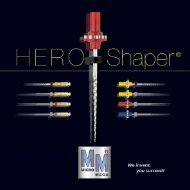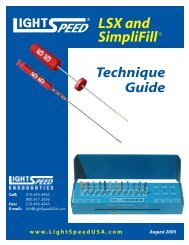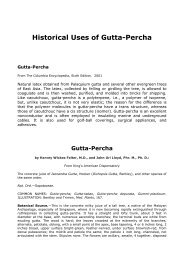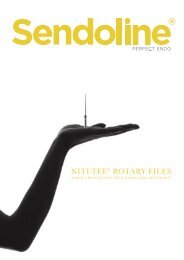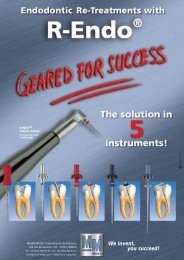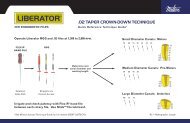R—Endo® Re—treatment - Micro Mega
R—Endo® Re—treatment - Micro Mega
R—Endo® Re—treatment - Micro Mega
You also want an ePaper? Increase the reach of your titles
YUMPU automatically turns print PDFs into web optimized ePapers that Google loves.
Frequently asked questions<br />
■ Do I have to obtain and/or check the apical<br />
patency? And how to do it?<br />
If possible it is useful to obtain and check the apical patency<br />
at the end of the preparation. A MMC file n°10 lightly<br />
pre-curved is sufficient and non-aggressive to do so.<br />
■ Can I fill the canal after R3 if it has reached the<br />
WL?<br />
R3 prepares the canal at a .04 taper and a diameter of 0.25<br />
mm, so it is possible to obturate in most cases. According<br />
to the clinical situation, if the filling needs a larger diameter<br />
or taper Rs can be used.<br />
■ What is the goal of Rs?<br />
As already said, Rs is an HERO Shaper ® n°30 .04 taper.<br />
This is an optional finishing file which can be used when<br />
preparation larger than 0.25 mm is needed.<br />
■ With which R-Endo ® file, and when can I do the<br />
circumferential filing?<br />
Re and R3 (and to some extent R2) were designed for<br />
circumferential filing in stepping back. Circumferential<br />
filing will be done with Re as with ENDOFLARE ® . With R2<br />
and R3 it will be practiced respectively in the middle third<br />
and in the apical third.<br />
■ Do I have to push on the R-Endo ® files to search<br />
the canal?<br />
The R-Endo ® files have a non active tip. Excessive pressure<br />
does not allow the canal catheterism if the canal aperture<br />
is not opened. The risk of going the wrong way and of<br />
“screwing” effect are increased by excessive pressure on<br />
the wrong axis.<br />
■ What can I do if the R-Endo ® files are too short?<br />
Generally the access is sufficient due to the re-preparation<br />
of the coronal chamber and the removal of the previous<br />
restorations and dentinal curretage of recurring caries. The<br />
R-Endo ® files are designed to give working length adapted<br />
to the ERT with a maximum of efficiency for each taper. Re,<br />
R1 and R2 are shorter because they are used in the coronal<br />
and middle part. If the canal input is not accessible a<br />
coronal reduction will be made for better access.<br />
■ Is the recommended sequence of the R-Endo ® files<br />
rigid?<br />
Each file is designed to work in each part of the canal to<br />
be re-treated. Each file allows the passage of the next<br />
instrument and preparation in safe conditions.<br />
Nevertheless the clinical situation (eg very large and<br />
tapered canal) can justify a shortening of the R-Endo ®<br />
sequence.<br />
17





